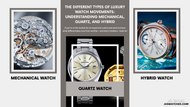The Different Types of Luxury Watch Movements: Understanding Mechanical, Quartz, and Hybrid
Posted by AIS Watches on Mar 7th 2023
A mechanical watch is a high-end timepiece that uses a series of gears, springs, and other parts to tell time. Quartz watches are powered by electricity and use oscillating crystals to keep time. Hybrid movements combine both quartz and mechanical components, making them much more accurate but also more expensive than either option alone. If you're in the market for an expensive watch and want to know what differentiates one from another—and why it matters—read on!

What is a Mechanical Movement?
Mechanical movements are the most common type of watch movement. They're also known as automatic or self-winding movements, which means they don't require you to wind them up manually like quartz watches do. Instead, they use an intricate system of gears and springs that work together to keep time without any help from you at all! This is what makes mechanical watches so special: there's no battery involved--just pure mechanical ingenuity!
Mechanical watches were invented centuries ago by Italian inventor Giovanni Branca; however, it wasn't until 1759 when Swiss watchmakers developed their own versions based off Branca's original design (they call this "Swiss Made"). Today there are many different types available on the market ranging from inexpensive ones under $100 to very expensive ones costing over $500K+.
What is the difference between a mechanical movement and an automatic movement?
There are two main types of watch movements: mechanical and automatic. Mechanical watches use a mainspring to power the movement, which must be wound manually by turning the crown on the side of your wristwatch. Automatic watches are self-winding, meaning they wind themselves as you wear them throughout the day. This means that an automatic movement can be more accurate than a manual one because its accuracy will stay consistent over time without requiring any additional effort from you (or having to remember to wind it).
Are there different types of automatic movements?
Yes, there are many different types of automatic movements. The most common one is the ETA 2824-2. This Swiss movement is used in many watches and has a reputation for being reliable, although some people who want an automatic watch may not be willing to settle for one that isn't made by a luxury brand like Rolex or Omega.
There are other types of movements as well: some companies create their own unique designs (like Patek Philippe), while others use modified versions of existing ones (like TAG Heuer).
What was the first automatic movement?
In 1945, the Omega calibre 1250 was released. It was a Lemania movement that used a camshaft to move a gear train and balance wheel. This was an important first step in automatic watchmaking because it allowed for more precise movements than earlier mechanical models.
What is a quartz movement?
Quartz movements are the most common type of movement in watches today. They use a battery to power a circuit that creates an electric current, which moves the hands on your watch and keeps time.
Quartz movements are usually found in watches that cost less than $100, and they're often used because they're more accurate than mechanical movements (more on that later). However, quartz movements aren't as durable or long lasting as mechanical ones; they have shorter lifespans and will require regular servicing by an expert watchmaker to keep them working properly over time.
What is a hybrid watch movement?
Hybrid movements are a combination of mechanical and quartz parts, resulting in a new and unique form of watch movement. One example of a hybrid movement is the mecha-quartz 6T63 from Seiko, which uses a quartz movement and a single stepper motor to drive the hands of a chronograph through a series of gears. Another example is the kinetic watch, which uses a mechanical rotor to charge a capacitor acting as the battery. Seiko also offers the spring drive, where an electronic module provides the timekeeping function, while a rotor and mainspring provide the power. The Omega SMP quartz has a mechanical movement powered by a battery-powered motor.
Smartwatches, which are purely electronic and typically require pairing with a smartphone, are gaining more popularity daily. Hybrid smartwatches are available, which combine traditional mechanical and quartz watches with smart features. These watches can be water-resistant and accept any watch strap of the proper width, rather than being locked to the straps of the smartwatch maker. Battery life is a significant advantage, with regular watch batteries lasting upwards of six months. Chronos, a crowdfunded solution, offers an elegantly simple answer to the dilemma of bringing a smartwatch into the fold. It is a disc that sticks to the back of any watch and enables a series of smart functions, just like a hybrid, and can move from watch to watch.
The integration of existing movement components with electronics, apps, telecommunications, and other innovative features is only going to enhance watchmakers' abilities in the future. The possibilities are endless, and with technology, we can expect more exciting advancements in watch movements.
 Menu
Menu




